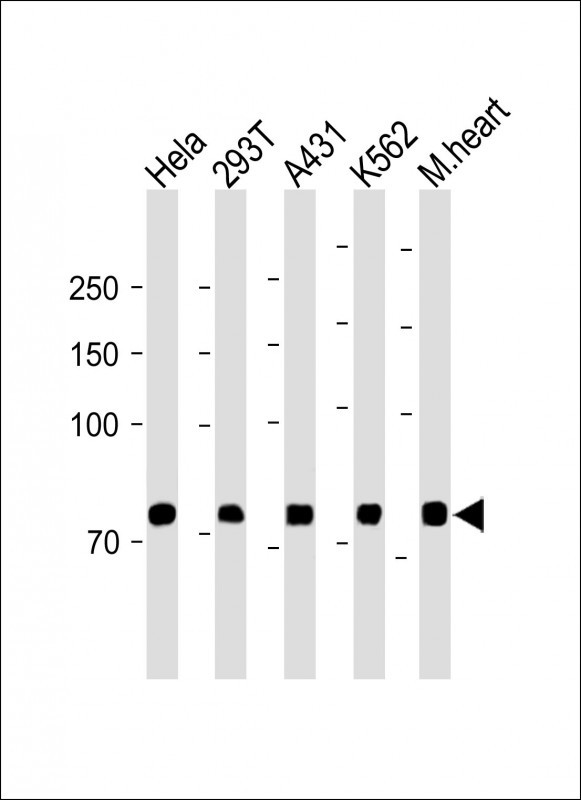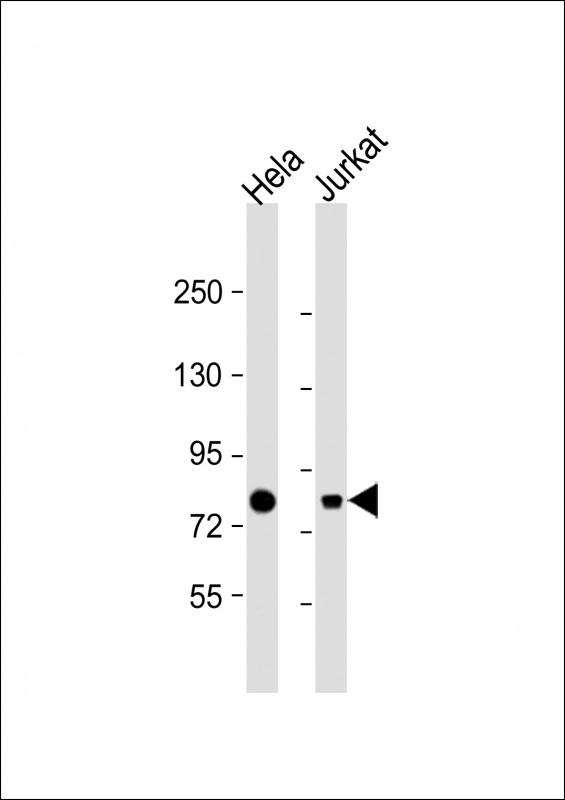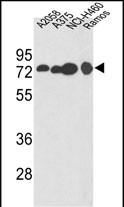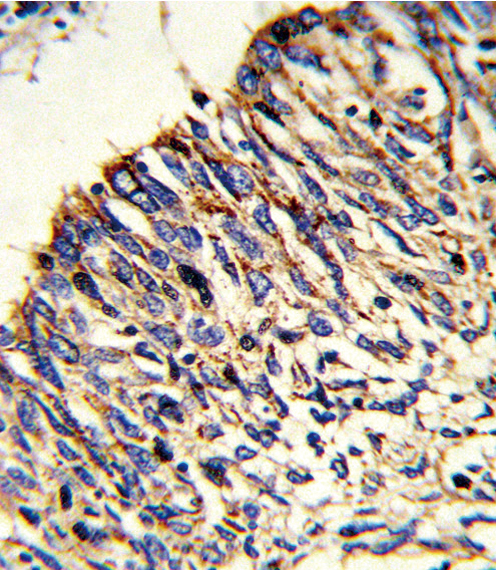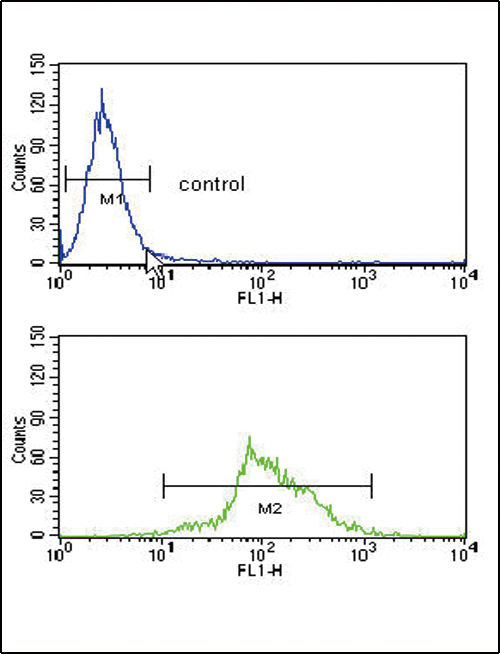HADHA Antibody (C-term)
Affinity Purified Rabbit Polyclonal Antibody (Pab)
- 产品详情
- 实验流程
- 背景知识
Application
| WB, IHC-P, FC, E |
|---|---|
| Primary Accession | P40939 |
| Reactivity | Human |
| Host | Rabbit |
| Clonality | Polyclonal |
| Isotype | Rabbit IgG |
| Calculated MW | 83000 Da |
| Antigen Region | 737-763 aa |
| Gene ID | 3030 |
|---|---|
| Other Names | Trifunctional enzyme subunit alpha, mitochondrial, 78 kDa gastrin-binding protein, TP-alpha, Long-chain enoyl-CoA hydratase, Long chain 3-hydroxyacyl-CoA dehydrogenase, HADHA, HADH |
| Target/Specificity | This HADHA antibody is generated from rabbits immunized with a KLH conjugated synthetic peptide between 737-763 amino acids from the C-terminal region of human HADHA. |
| Dilution | WB~~1:1000 IHC-P~~1:100~500 FC~~1:10~50 E~~Use at an assay dependent concentration. |
| Format | Purified polyclonal antibody supplied in PBS with 0.09% (W/V) sodium azide. This antibody is purified through a protein A column, followed by peptide affinity purification. |
| Storage | Maintain refrigerated at 2-8°C for up to 2 weeks. For long term storage store at -20°C in small aliquots to prevent freeze-thaw cycles. |
| Precautions | HADHA Antibody (C-term) is for research use only and not for use in diagnostic or therapeutic procedures. |
| Name | HADHA |
|---|---|
| Synonyms | HADH |
| Function | Mitochondrial trifunctional enzyme catalyzes the last three of the four reactions of the mitochondrial beta-oxidation pathway (PubMed:1550553, PubMed:29915090, PubMed:30850536, PubMed:8135828, PubMed:31604922). The mitochondrial beta-oxidation pathway is the major energy-producing process in tissues and is performed through four consecutive reactions breaking down fatty acids into acetyl-CoA (PubMed:29915090). Among the enzymes involved in this pathway, the trifunctional enzyme exhibits specificity for long-chain fatty acids (PubMed:30850536, PubMed:31604922). Mitochondrial trifunctional enzyme is a heterotetrameric complex composed of two proteins, the trifunctional enzyme subunit alpha/HADHA described here carries the 2,3-enoyl-CoA hydratase and the 3-hydroxyacyl-CoA dehydrogenase activities while the trifunctional enzyme subunit beta/HADHB bears the 3-ketoacyl-CoA thiolase activity (PubMed:29915090, PubMed:30850536, PubMed:8135828). Independently of subunit beta, HADHA also exhibits a cardiolipin acyltransferase activity that participates in cardiolipin remodeling; cardiolipin is a major mitochondrial membrane phospholipid (PubMed:23152787, PubMed:31604922). HADHA may act downstream of Tafazzin/TAZ, that remodels monolysocardiolipin (MLCL) to a cardiolipin intermediate, and then HADHA may continue to remodel this species into mature tetralinoleoyl-cardiolipin (PubMed:31604922). Has also been proposed to act directly on MLCL; capable of acylating MLCL using different acyl-CoA substrates, with highest activity for oleoyl-CoA (PubMed:23152787). |
| Cellular Location | Mitochondrion. Mitochondrion inner membrane Note=Protein stability and association with mitochondrion inner membrane do not require HADHB. |
For Research Use Only. Not For Use In Diagnostic Procedures.
Provided below are standard protocols that you may find useful for product applications.
BACKGROUND
HADHA is the alpha subunit of the mitochondrial trifunctional protein, which catalyzes the last three steps of mitochondrial beta-oxidation of long chain fatty acids. The mitochondrial membrane-bound heterocomplex is composed of four alpha and four beta subunits, with the alpha subunit catalyzing the 3-hydroxyacyl-CoA dehydrogenase and enoyl-CoA hydratase activities.
REFERENCES
Sims,H.F., et.al., Proc. Natl. Acad. Sci. U.S.A. 92 (3), 841-845 (1995)
终于等到您。ABCEPTA(百远生物)抗体产品。
点击下方“我要评价 ”按钮提交您的反馈信息,您的反馈和评价是我们最宝贵的财富之一,
我们将在1-3个工作日内处理您的反馈信息。
如有疑问,联系:0512-88856768 tech-china@abcepta.com.























 癌症的基本特征包括细胞增殖、血管生成、迁移、凋亡逃避机制和细胞永生等。找到癌症发生过程中这些通路的关键标记物和对应的抗体用于检测至关重要。
癌症的基本特征包括细胞增殖、血管生成、迁移、凋亡逃避机制和细胞永生等。找到癌症发生过程中这些通路的关键标记物和对应的抗体用于检测至关重要。 为您推荐一个泛素化位点预测神器——泛素化分析工具,可以为您的蛋白的泛素化位点作出预测和评分。
为您推荐一个泛素化位点预测神器——泛素化分析工具,可以为您的蛋白的泛素化位点作出预测和评分。 细胞自噬受体图形绘图工具为你的蛋白的细胞受体结合位点作出预测和评分,识别结合到自噬通路中的蛋白是非常重要的,便于让我们理解自噬在正常生理、病理过程中的作用,如发育、细胞分化、神经退化性疾病、压力条件下、感染和癌症。
细胞自噬受体图形绘图工具为你的蛋白的细胞受体结合位点作出预测和评分,识别结合到自噬通路中的蛋白是非常重要的,便于让我们理解自噬在正常生理、病理过程中的作用,如发育、细胞分化、神经退化性疾病、压力条件下、感染和癌症。
